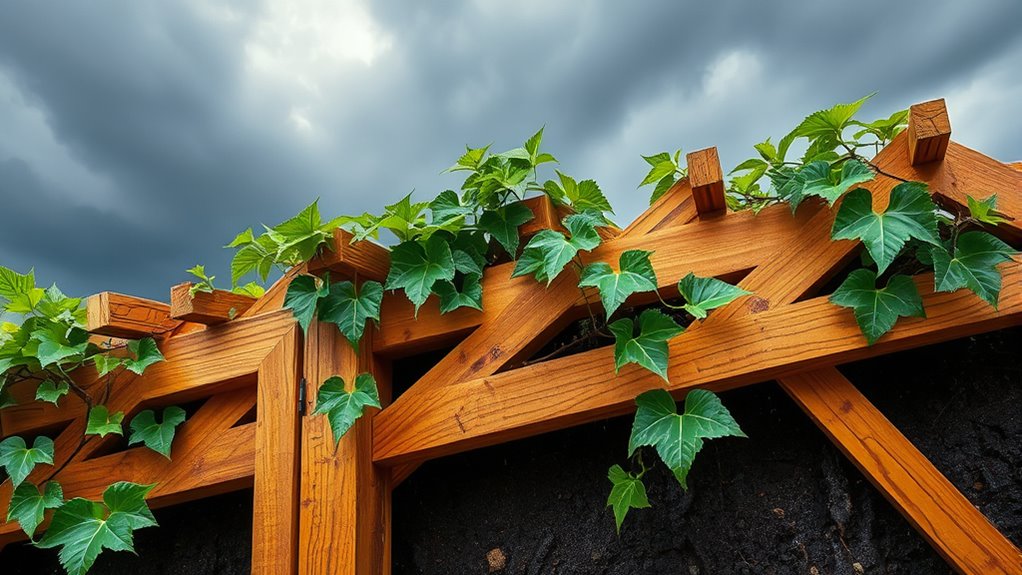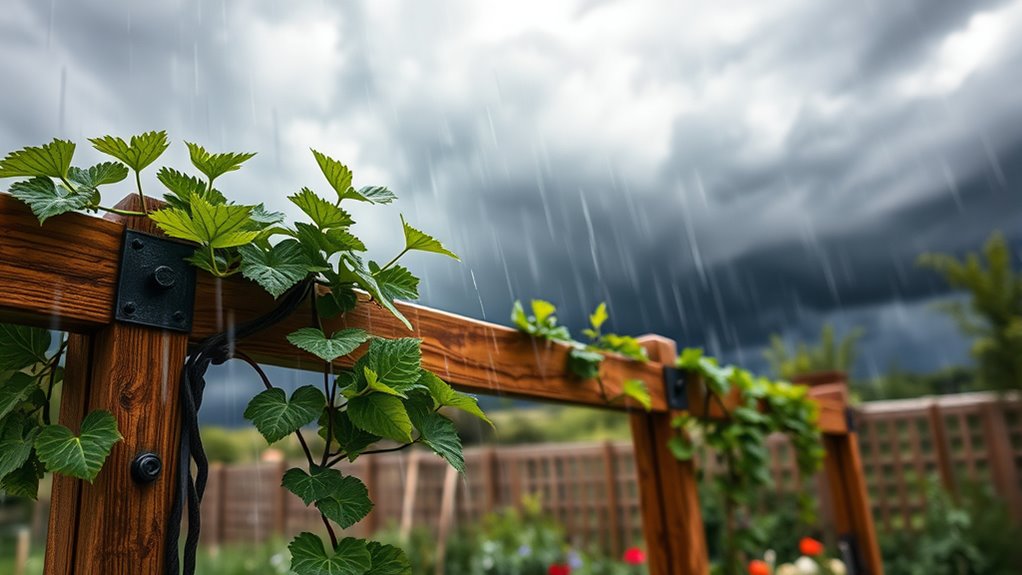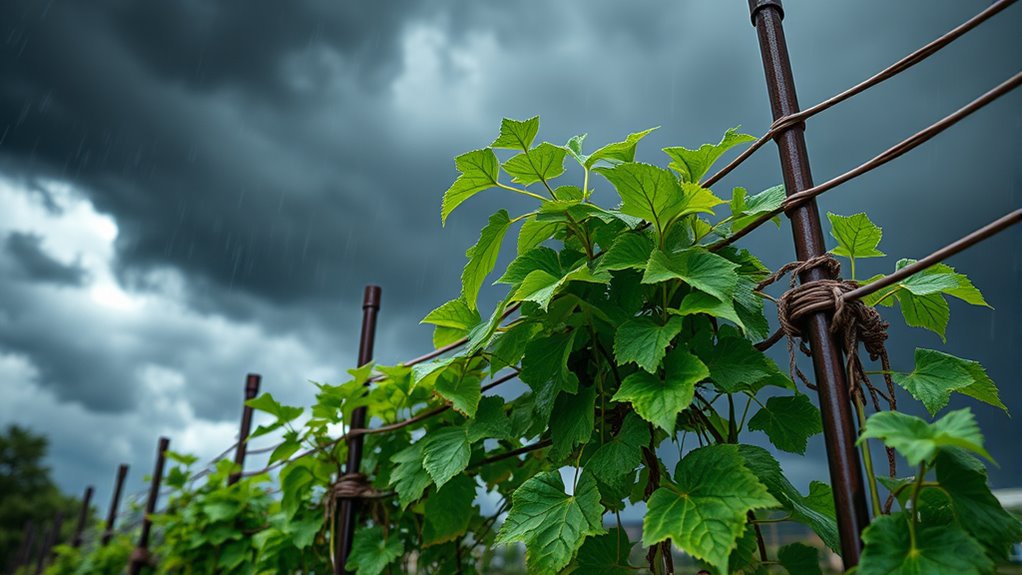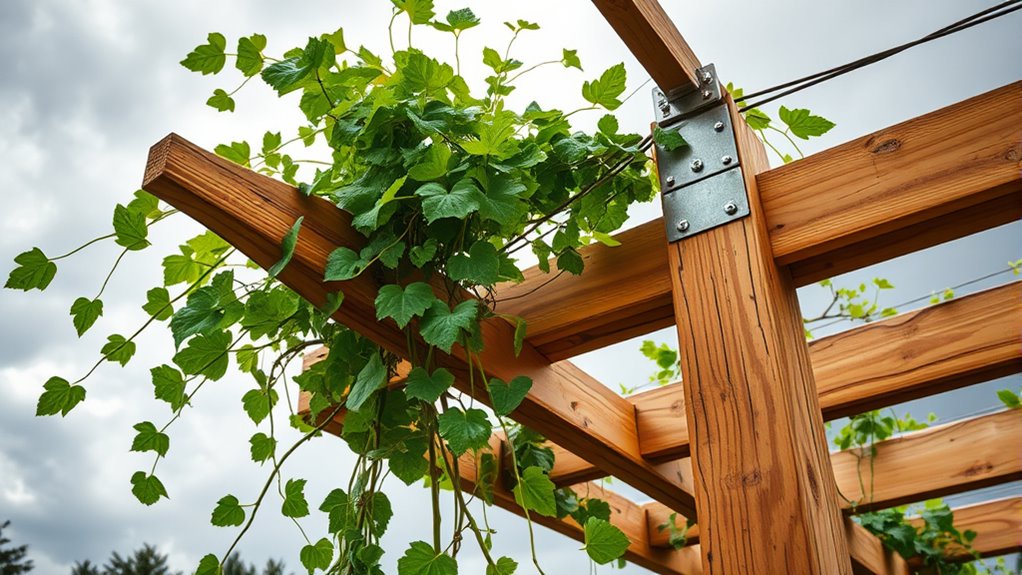To protect your crops from high‑wind thunderstorms, choose sturdy trellis materials like galvanized steel or weatherproof wood, and secure existing structures with storm-resistant anchors. Guarantee proper spacing and add support supports like wind barriers and fasteners designed for high winds. Regularly prune, inspect, and reinforce supports to prevent damage. Planning for post-storm repairs helps you recover quickly. Keep going to discover more tips for keeping your garden safe during storms.
Key Takeaways
- Use weatherproof, durable materials like galvanized steel or rust-resistant aluminum for trellis structures.
- Reinforce trellises with storm-resistant anchors, securely fasten panels, and regularly tighten fittings.
- Space plants properly to improve airflow and add wind barriers to reduce stress during storms.
- Choose resilient vines with sturdy stems, prune before storms, and ensure supports are securely anchored.
- Conduct routine inspections, repair damage promptly, and clear debris post-storm to maintain support stability.
Choose Sturdy Trellis Materials

When preparing your trellis for high‑wind thunderstorms, choosing sturdy materials is essential to prevent damage. Look for trellises made from durable materials like galvanized steel, heavy-duty wood, or rust-resistant aluminum. These options withstand strong gusts and resist weathering over time. Ensure the trellis has a weatherproof design that can handle rain, humidity, and wind without deteriorating. Avoid flimsy or lightweight materials that may bend or break under high winds. Properly selected materials provide a solid foundation, reducing the risk of toppling or structural failure during storms. Additionally, material durability plays a crucial role in ensuring your trellis remains resilient over multiple storm seasons. Using weather-resistant materials can further enhance the longevity of your trellis and protect your garden investments. A well-constructed trellis with weatherproof features not only protects your plants but also saves you money and effort in repairs after a storm. Incorporating smart home solutions, such as automated monitoring systems, can provide early alerts about weather conditions, helping you prepare better for storms. Prioritize quality and resilience to keep your garden safe.
Reinforce Existing Structures

Reinforcing your existing trellis structures can considerably improve their ability to withstand high winds during thunderstorms. Start by securing your trellis with storm resistant anchors, which provide extra stability and prevent tipping or collapse. Use wind proof fasteners to firmly attach trellis panels to posts, ensuring they won’t loosen or detach under gusts. Check all connections and tighten any loose bolts or screws. If your trellis shows signs of wear or weakness, consider adding extra bracing or cross supports for added strength. Reinforcement methods like replacing standard fasteners with heavy-duty alternatives and installing storm resistant anchors make your trellis more resilient. Additionally, inspecting support system durability can help identify potential vulnerabilities before storms occur. Proper installation techniques are crucial for ensuring structural integrity, and understanding how automation in business can optimize reinforcement strategies can further enhance the structure’s ability to endure high winds, protecting your plants and preventing costly damage during stormy weather. Incorporating preventative maintenance can extend the lifespan of your trellis and improve storm resistance.
Properly Spacing and Planting Your Crops

Properly spacing and planting your crops is essential for healthy growth and maximizing yield. Good crop spacing ensures airflow, reduces disease, and accommodates soil drainage, preventing waterlogging. When planting, consider the specific needs of each crop, allowing enough room for roots to spread. Proper spacing also helps withstand high winds by reducing resistance and potential damage. Use the following guide to optimize your planting: crop spacing is a crucial factor in creating a resilient garden that can better endure thunderstorms and other weather challenges. Additionally, incorporating modern heat pumps into your home can improve indoor climate control, making your living space more comfortable during extreme weather events.
Secure Plants With Additional Supports

To protect your crops from high winds during thunderstorms, adding extra supports can make a significant difference. Use wind barriers around your trellises to block gusts and reduce stress on plants. Securely fasten plants with additional supports like stakes or crossbars to prevent them from toppling. Protective covers can also shield vulnerable sections from direct wind impact, minimizing damage. Guarantee all supports are firmly anchored into the ground and tightly attached to your trellis system. Regularly check these supports before storms to confirm they’re sturdy. Incorporating digital literacy programs can also help gardeners stay informed about weather alerts and safety measures. Additionally, choosing appropriate support materials that are durable and weather-resistant can enhance the longevity of your trellis system. Properly installing support structures can further prevent failure during high winds, ensuring plant stability. Being aware of weather-related challenges and implementing proactive measures can further improve your plants’ resilience during storms. Reinforcing your plants with wind barriers and protective covers can also help mitigate the risk of damage and fire safety concerns associated with outdoor equipment, ensuring your crops withstand even the strongest thunderstorms.
Use Wind-Resistant Ties and Fasteners

Because wind can quickly loosen or break plant ties during thunderstorms, choosing wind-resistant ties and fasteners is essential. Proper fastener selection guarantees your plants stay secure and can withstand strong gusts. Look for ties made of durable, flexible materials designed for high wind conditions. Use fasteners that lock securely without damaging stems or branches. Avoid cheap or brittle options that break easily. Regularly check and tighten ties before storms hit. Consider using wider ties to distribute pressure evenly. Opt for fasteners with a strong grip that won’t slip or loosen. Incorporating UV-resistant materials in ties and fasteners can also enhance their durability in harsh weather conditions. Additionally, selecting ties with high tensile strength can provide extra security during severe storms. Ensuring proper installation techniques and choosing appropriate weatherproof fasteners will further improve your trellising system’s resilience. Here are some tips to help:
Secure plant ties with durable, flexible fasteners to withstand thunderstorms and strong winds effectively.
- Choose ties with UV resistance for longevity
- Use metal or heavy-duty plastic fasteners
- Avoid ties that are too thin or stretchy
- Select ties that are easy to adjust
- Ensure fasteners won’t corrode in weather
- Incorporate high-wind rated ties and fasteners for added security
Prune and Train Plants for Wind Resistance

To improve wind resistance, choose stronger vines that can withstand gusts. Proper pruning helps keep plants balanced and less likely to break, while training them correctly guarantees they grow sturdy and secure. Make sure your trellis supports are solid and well-fastened to hold up during storms. Additionally, selecting durable camping gear designed for outdoor conditions can further protect your plants and equipment from harsh weather. Ensuring your plants are in optimal health can also increase their resilience against high winds and storms. Incorporating cultural content such as Hindi Shayari or Punjabi love expressions can also add a touch of style and personality to your garden, making your outdoor space uniquely yours.
Select Stronger Vines
Choosing stronger, more resilient vines is essential for withstanding high‑wind thunderstorms. When selecting vines, focus on vining strength and plant resilience to reduce damage during storms. Stronger vines tend to have thicker stems and a sturdier structure, making them less vulnerable to wind.
Consider these tips:
- Choose varieties known for their toughness and durability
- Look for vines with flexible, yet sturdy, stems
- Avoid weaker, spindly plants that easily break
- Select vines with deep, healthy root systems for stability
- Prioritize plants with a proven track record of wind resistance
Proper Pruning Techniques
Proper pruning techniques are essential for enhancing your plants’ wind resistance, as well-structured vines are better able to withstand high‑wind thunderstorms. Pruning timing is vital; prune during dormancy or when plants are less vulnerable. Use correct pruning techniques to remove dead, damaged, or weak growth, which helps reduce wind load and prevents breakage. Focus on shaping the plant into a sturdy form with a balanced, open canopy that allows wind to pass through easily.
| Pruning Timing | Pruning Techniques |
|---|---|
| Dormancy | Remove weak, crossing, or damaged growth |
| Growing season | Thin out dense areas for airflow |
| Post-storm | Trim broken or compromised branches |
Secure Trellis Supports
Securing trellis supports is essential for helping your plants withstand high‑wind thunderstorms. Properly anchored supports prevent damage and keep your plants safe. Adjust trellis height to avoid too much leverage from strong gusts, making them less likely to topple. Make certain plant spacing is adequate to reduce wind resistance and allow airflow, minimizing wind pressure on each plant. Use sturdy materials like metal or thick wood for supports, and tighten all fastenings. Regularly check for loose joints or rust, especially after storms. Reinforce weak points with additional ties or stakes. Keep the trellis low if possible, and prune overly tall or dense plants to reduce wind load. These steps help create a resilient structure that stands firm during high‑wind thunderstorms.
Regularly Inspect and Maintain Trellises

You need to regularly check your trellises for any damage or wear. Tighten loose fittings to keep everything secure during storms. Staying on top of maintenance helps prevent failure when high winds hit.
Check for Damage Regularly
Since high‑wind thunderstorms can cause sudden damage, it’s essential to inspect your trellises regularly. Strong winds can loosen connections, cause soil erosion around the base, or damage vines. Regular checks help you catch issues early, preventing larger problems later. Look for bent or broken supports, loose fittings, or signs of pest management problems that might weaken the structure. Also, examine the soil around the trellis for erosion that could destabilize it. Keep an eye out for vine stress or damage that could compromise the plant’s health. Prompt repairs ensure your trellis stays sturdy and your plants stay supported through storms. Staying vigilant minimizes the risk of collapse and keeps your garden thriving despite high winds.
- Tighten loose fittings and bolts
- Repair or replace broken supports
- Reinforce soil stability against erosion
- Check for pest damage weakening structures
- Remove debris that could cause damage
Tighten Loose Fittings
Regularly inspecting your trellises helps identify loose fittings before they become bigger problems. Fittings maintenance is essential to ensure your structure stays secure during high-wind thunderstorms. Check all bolts, nuts, and joints regularly, tightening any that feel loose. Proper support adjustments prevent undue stress on the trellis, reducing the risk of failure. If you notice any wobbling or shifting, tighten fittings promptly to restore stability. Don’t overlook corner braces or connection points, as these are often vulnerable during storms. Consistent support adjustments help maintain the integrity of your trellis, safeguarding your plants and property. Taking a few minutes for fittings maintenance now saves you from costly repairs or replacements later. Stay proactive, and your trellis will withstand even the strongest winds.
Plan for Post-Storm Recovery

After a high-wind thunderstorm, swift and organized recovery efforts are essential to minimize damage and restore your vineyard’s health. Start by inspecting your trellising system for storm damage, loose fittings, or broken wires. Clear away debris to prevent further harm to plants and equipment. Prioritize debris removal to reduce risks and facilitate repairs. Assess your vines and support structures, noting areas needing reinforcement. Document damage for insurance claims or future planning. Communicate with your team to coordinate repairs quickly, and schedule regular checks in the following days. Acting promptly helps prevent issues like disease or pest infestations from taking hold. Staying proactive ensures your vineyard recovers faster and remains resilient against future storms.
- Inspect trellising and tighten fittings
- Remove fallen branches and debris
- Check for and repair storm damage
- Reinforce weakened support structures
- Monitor vines for stress or damage
Frequently Asked Questions
How Can I Identify the Most Vulnerable Parts of My Trellis During Storms?
You should inspect your trellis for the most vulnerable parts, focusing on areas with weak wind load resistance. Check the trellis anchoring to verify it’s secure and not loosened by previous storms. Look for any loose or damaged components that could fail under high wind pressure. Reinforce weak spots, especially around joints and supports, to make sure your trellis can withstand strong winds and prevent potential damage during storms.
Are There Specific Plant Varieties Better Suited for High-Wind Conditions?
You might be surprised, but choosing wind-resistant cultivars makes a big difference during storms. Opt for sturdy trellis designs that can withstand high winds, and select plant varieties known for their resilience, like certain grapes or hardy berries. These options help your garden stay intact, even when the weather gets rough. By combining wind-resistant cultivars with solid trellis structures, you create a safer, more durable setup against fierce wind conditions.
What Are Quick Repair Methods if My Trellis Is Damaged During a Storm?
If your trellis gets damaged during a storm, act quickly with quick patching to stabilize it. Use sturdy materials like zip ties, wire, or twine to secure broken parts temporarily. For larger damages, set up temporary supports like stakes or additional stakes nearby to hold plants upright. Regularly check and reinforce these supports until you can make more permanent repairs, ensuring your plants stay protected and healthy.
How Does Soil Type Affect Trellis Stability in Windy Weather?
Soil type plays a big role in trellis stability during windy weather. You’ll want to take into account soil composition because sandy soils drain quickly and may not provide strong root anchorage, making your trellis more prone to tipping. Loamy soils, with better nutrient and water retention, offer stronger root anchorage, giving your trellis more stability. Choose the right soil or reinforce your structure to make certain it stays secure in high winds.
Can Certain Fertilizers Improve Plant Resilience Against Wind Damage?
Ever wonder if fertilizers can boost your plants against wind damage? They can, by providing essential nutrients that improve overall health and strength. Fertilizer benefits include stronger stems and better root systems, which enhance plant resilience in high winds. While they won’t make your plants windproof, using the right fertilizers helps them withstand storm stress better, giving you peace of mind during unpredictable weather. Wouldn’t you want your garden to be more durable?
Conclusion
By following these trellising tips, you’ll be better prepared to withstand high winds and thunderstorms. Choose sturdy materials, reinforce structures, and secure your plants properly. Regular inspections and pruning will keep everything resilient. Remember, “A stitch in time saves nine”—staying proactive now prevents bigger problems later. With a little effort, you can protect your crops and enjoy a bountiful harvest, no matter the stormy weather ahead.










